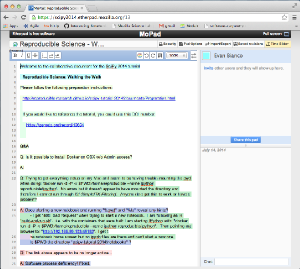The event that connects like the web
/ Last week, Matt, Ben, and I attended SciPy 2014, the 13th annual scientific computing with Python conference. On a superficial level, it was just another conference. But there were other elements, brought forth by the organizers and participants (definitely not just attendees) and slowly revealed over the week. Together, the community created the conditions for a truly remarkable experience.
Last week, Matt, Ben, and I attended SciPy 2014, the 13th annual scientific computing with Python conference. On a superficial level, it was just another conference. But there were other elements, brought forth by the organizers and participants (definitely not just attendees) and slowly revealed over the week. Together, the community created the conditions for a truly remarkable experience.
Immutable accessibility
By design, the experience starts before the event, and continues after it is over. Before each of the four half-day tutorials I attended, the instructors posted their teaching materials, code, and setup instructions. Most oral presentations did the same. Most code and content was served through GitHub or Bitbucket and instructions were posted using Mozilla's Etherpad. Ultimately the tools don't matter — it's the intention that is important. Instructors and speakers plan to connect.
Enhancing the being there
Beyond talks and posters, here are some examples of other events that were executed with engagement in mind:
 Keynote presentations. If a keynote is truly key, design the schedule so that everyone can show up — they're a great way to start the day on a high note.
Keynote presentations. If a keynote is truly key, design the schedule so that everyone can show up — they're a great way to start the day on a high note.- Birds of a Feather sessions are better than a panel discussion or Q&A. Run around with a microphone, and record notes in Etherpad.
- Lightning talks at the end the day. Anyone can request 5 minutes on a show & tell. It was the first time I've heard applause erupt in the middle of a talk — and it happened several times.
- Developer sprints take an hour to teach newbies how to become active members of your community or your project. Then spend two-days showing them how you work.
Record all the things
SciPy is not a conference, it's a hypermedia stream that connects networks across organizational boundaries. And it happens in real time — I overheard several people remarking in astonishment that the video of so-and-so's talk earlier that same morning was already posted online. My trained habit of frantic note-taking was redundant, freeing my concentration for more active listening. Instructors and presenters published their media online, and the majority of presenters pulled up interactive iPython notebooks in the browser and executed code on the fly.
As an example of this, here's Karl Schleicher of Sergey Fomel's group at UT, talking about reproducing the results from a classic paper in The Leading Edge, Spitz (1999):
We need this
On Friday evening Matt remarked to one of the sponsors, "This is the closest thing I have seen to what a conference should be". I think what he meant by that is that it should be about connecting. It should be about pushing our work out to the largest possible scope. It should be open by default, and designed to support ideas and conversations long after it is over. Just like all the things that the web is for as well.
Our question: Can we help SEG, AAPG, or EAGE deliver this to our community? Or do we have to go and build it?








 Except where noted, this content is licensed
Except where noted, this content is licensed